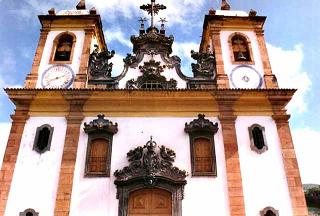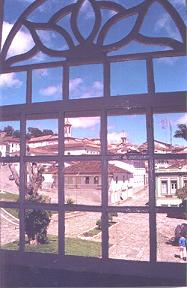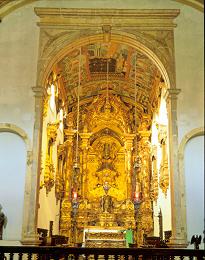Advertising by Google
Ouro Preto
Population: 66,277
Distance from Belo Horizonte: 99 km (61 mi); Rio de Janeiro: 398 km (247 mi); São Paulo: 618 km (384 mi)
The name Ouro Preto means Black Gold; the first stones found in the river Tripuí, near the city, were black stones (a kind of gold nuggets covered with iron oxid).
The city was formerly known as Vila Rica (Rich Town), and was the first capital of the State of Minas Gerais.

Nossa Senhora do Carmo
Protected by mountains, Ouro Preto embodies the History of Brazil's gold rush era from the 17th and 18th century (read more about the History of Minas Gerais).
Settlers and religious orders filled the town with cobblestone streets, austere houses and small churches with richly decorated interiors. The result in terms of architecture is an impressive harmony. Two geniuses of Brazilian arts, architec and sculptor Antônio Francisco Lisboa, the Aleijadinho, born in Ouro Preto, and painter Mestre Athayde, born in Mariana, poured their creativity and spirit into making Ouro Preto a unique town.
At that time, Ouro Preto was the richest Brazilian city, the place where, by order of Portugal, the gold production was brought to be gauged and taxed; not by coincidence, the Inconfidência Mineira, the first major attempt of independence, led by Tiradentes, took place in Ouro Preto. As years passed by, the gold mines were exhausted, and the town fell into oblivion.
What seemed a curse turned into a blessing: the lack of wealth prevented changes in the architecture, and all the richness of the buildings was preserved. Ouro Preto was, in 1980, the first Brazilian town to be listed by Unesco as one of the World Heritage Sites.
More recently, the establishment of industries in the surrounding area, the growth of population and increase in traffic have threatened the harmony inherited from the past. A particular cause of concern is the street carnival of Ouro Preto, which attracts students from all over Brazil, who crowd the cities while playing loud music.
Ouro Preto - Places to Visit

Nossa Senhora do Rosário
Notice that Ouro Preto is a city of valleys and hills; wear comfortable shoes, bring water. Most attractions close on Mondays. Some churches charge an admitance fee; some churches do not allow photos
or filming.
There are many "tour guides" offering their services everywhere in town, but you should only hire people endorsed by the tourist offices.
Museu da Inconfidência. What used to be the city hall and jail (1785 - 1855), built with neoclassiocal touches, is today a museum which holds the mortal remains of the twelve rebels, a collection of religious art and copies of Aleijadinho's works.
Museu de Mineralogia and Escola de Minas. This building was erected in 1741 and served as the Governor's house until 1898. When the capital of the State was moved to Belo Horizonte, the building was turned into the School of Mining, and today houses the Musueum of Science and Technology and the Museum of Mineralogy. The internal fountain was designed by Aleijadinho.
Municipal Theater and Opera House. Built in 1769, this theather is in the shape of a lyre and has perfect acoustics. It's the oldest theater still open in Brazil. Open for visitation during the day, and for concerts in some evenings; there is a Winter Festival, in July.
Casa dos Contos. Contos was the name of Portuguese currency in colonial times. Between 1724 and 1735 this building served as the Mint, where gold was weighed and cast. It was also where the rebels of Inconfidência were imprisoned. One of the rebels, poet Cláudio Manoel da Costa, died here in 1789. As was usual, the lower part of the building served as slave quarters. This is one of the best preserved houses in Ouro Preto. It contains an exhibit of 18th and 19th century furniture and operates as a library and research center for the gold rush era.
The gold mines. There is no more gold, but the mines are still there and open to visitation. The most famous mine is the Chico Rei, excavated in the 18th century. The name means King Chico; the story goes that the mine belonged to a slave who had been a king in Africa and had money stashed to buy his freedom.
Ouro Preto Churches
Ouro Preto Churches. Guide of the most famous churches in Ouro Preto.
Ouro Preto events

Two events in Ouro Preto have national projection: the carnival and the Holy Week.
Mouth to mouth propaganda have made carnival in Ouro Preto very popular among college students. The city has a large proportion of students, who during the year live in places called Repúblicas (a rented house maintained and ruled by themselves). During carnival, the Republicas are literally packed with residents and many visitors coming from all over the country. The hills prevent traffic of heavy sound trucks, but don't stop people from feasting all night and day. Check out some photos of carnival in Ouro Preto.
Ouro Preto sees many processions along the year, but the most impressive one happens during the Holy Week, ending on Easter Sunday, when the town is decorated for procession of angels, brotherhoods and Biblical figures. Everyone goes out to cover the streets with flowers and sawdust. Colorful rugs and flags are hung from the windowns. Curiosity: in even-numbered years the procession leaves from Igreja Nossa Senhora do Pilar and heads towards the plaza of Igreja Bom Jesus de Matosinhos, whereas in odd-numbered years it starts in Nossa Senhora da Conceição de Antonio Dias and heads towards Nossa Senhora do Rosário.
Hotels in Ouro Preto
Hotels in Ouro Preto. List of hotels in Ouro Preto.
More sites about Ouro Preto:
Ouro Preto. Official site.
Back to Top